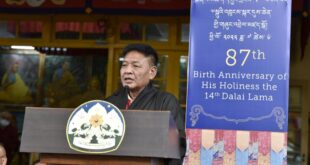http://www.hindustantimes.com/books/book-review-the-noodle-maker-of-kalimpong-is-gripping/article1-1377836.aspx
The Noodle Maker of Kalimpong recounts the contradictory twists and turns in the desperate last-ditch efforts by Tibet to survive as a culture and people. The story is told by Gyalo Thondup, the older brother of the Dalai Lama and a key figure in the Tibetan struggle. The story covers the three major phases of the struggle: armed resistance to Chinese rule, raising the issue of Tibet at the UN, and compromise and dialogue with Beijing. In each of these turns in policy, Gyalo Thondup played a major role. His account of the Tibetan struggle is a welcome contribution to the growing body of Tibetan resistance literature and on the CIA’s involvement.
Some of the background to the events he recounts has never been told before. The only other Tibetan to tell the whole story is the late Lhamo Tsering in his exhaustive work, Resistance, and his son Tenzing Sonam in his compelling documentary, The Shadow Circus: the CIA in Tibet. Apart from these, this aspect of Tibet’s struggle for survival has been mainly hogged by CIA operatives or by American writers drawn to the subject. Gyalo Thondup’s perspective on the cloak-and-dagger game Tibet briefly played with the CIA will remain the authoritative Tibetan account of this episode of the Tibetan struggle.
The Noodle Maker of Kalimpong recounts the far end of the Great Game in its new avatar as the Cold War. The players have changed but the geopolitical goal remained the same: imperial expansion and efforts to thwart it. Tibet was a natural target of the ambitions of the great powers because of its massive geographic weight and size. Thrusting almost three miles into the sky and covering an area of 2.5 million square kilometres and ringed on three sides by the highest mountain ranges in the world, the Tibetan plateau constituted, in those days, the most effective defence anywhere in the world.
In the Great Game, the key players were British India and Tsarist Russia. Russia’s expansion into Central Asia alerted London to the possibility of a Russian grab at India. Viceroy Lord Curzon’s “forward policy” resulted in the British invasion of Tibet in 1904. In Lhasa, the British found no evidence of Russian influence but one unintended consequence of the invasion was to alert Manchu China to the possibility of an invasion of the mainland through what it considered its backyard. To ward off such an event, Manchu troops marched to Lhasa in 1910 to make China’s presence in Tibet permanent.
However, the Manchu dynasty was overthrown in 1911 and the Tibetan government sent packing the Manchu troops stationed in Lhasa. But a united and resurgent communist China made good Manchu China’s claims on Tibet when it invaded the country in 1949-1950. Gyalo Thondup narrates the genesis of Tibetan resistance to the invasion and the efforts he and his team made to galvanize international support. This new game Tibet was caught up in was called the Cold War, the contest for influence between the capitalist and socialist camps. In this contest, seeing Tibet as “a nuisance value”, the CIA came to help half-heartedly, not sure of the strategic worth of Tibet nor of the Tibetan resistance and certainly not sure where in the world Tibet was in the first place. Mikel Dunham’s Buddha’s Warriors tells the story of how John Greaney, the deputy head of the Tibetan Task Force at Langley, helped Allen Dulles, the director of the CIA, spot Tibet on the map.
“Dulles asked me ‘Now where is Tibet?’ We stand up on the leather couch in his office and he has a National Geographic world map there, and he’s pointing to Hungary, and he says, ‘Is that Tibet?’ And I say, ‘No, sir, it’s over here by the Himalaya’. The CIA help which Gyalo Thondup organised with his deputy Lhamo Tsering consisted of training about 250 Tibetan resistance fighters in Saipan and Camp Hale in Colorado, air-dropping them with arms in Tibet and establishing regular radio contact between the roughly 30,000-strong resistance and Langley. When the resistance collapsed in Tibet, the radio contact enabled the Tibetans to seek timely granting of asylum in India to the Dalai Lama. Thondup blames the collapse of the resistance not to the fighting qualities of the Tibetans but the CIA’s “paltry support.” He says, “Mao was not the only one to cheat the Tibetans. The CIA did, too.”
With the fall of Tibet, the resistance with 2000 new recruits relocated itself to Mustang in Nepal. But that pocket of Tibetan resistance too crumbled when the US allied itself with China to confront the Soviet menace. The rapprochement between America and China also created the political climate for China to initiate a round of discussions with the representatives of the Dalai Lama. The responsibility for conducting these discussions fell on Gyalo Thondup, who was invited to Beijing to meet Deng Xiaoping. According to Thondup, Deng came straight to the point. “No future leader could ever be able to negotiate an independent Tibet. But except independence, everything is negotiable. Everything can be discussed. This is what I want to raise with you today. This is what I want to discuss with you.”

Undated file photograph of the Dalai Lama’s older brother, Gyalo Thondup, in Dharamsala. (AFP Photo)
Gyalo Thondup’s story is gripping and told with flair. Its value is enhanced by his personal insights into the character of the giants of the twentieth century, Nehru, Chiang Kai-shek, Deng Xiaoping and Lee Teng-hui, with whom he interacted in the course of his effort for the cause of a noble struggle. The first leader to express such sentiments to the Tibetan struggle was Lee Teng-hui, the President of Taiwan. According to Thondup, “The president was full of apologies and sympathy for Tibet. The government of the Republic of China felt ashamed, he said, at how little it had been able to accomplish compared to the tremendous achievements of the Tibetan refugees. The Dalai Lama had arrived in India with only his bare hands – no army, no money, and no territory – Lee said, but he had achieved so much, singlehandedly establishing himself on the international stage, becoming a leading figure in India and the world. The accomplishments of the Nationalist government, even with its own territory, financial resources, and trained personnel, had been limited, he said.” The only blemish in an otherwise great story is when Gyalo Thondup turns his gaze from China to Tibetan society to make wild accusations. These accusations seem petty and distract from his struggle for Tibet for which he gave his active life.
Thubten Samphel is the director of the Tibet Policy Institute and author of Falling Through the Roof


